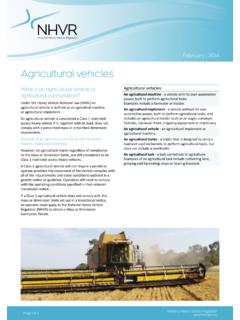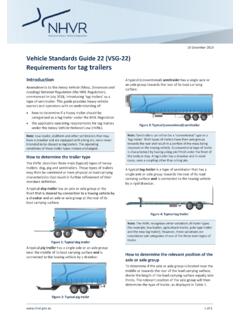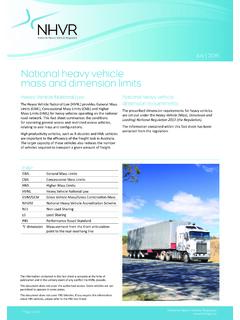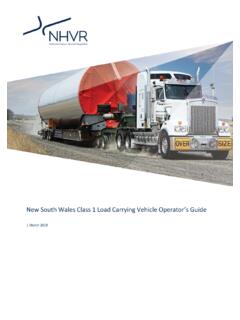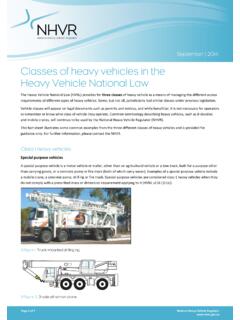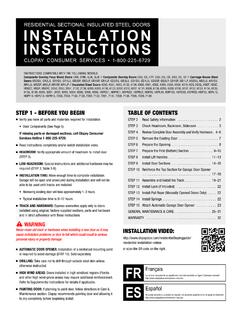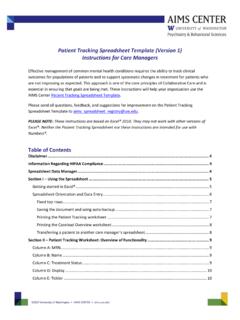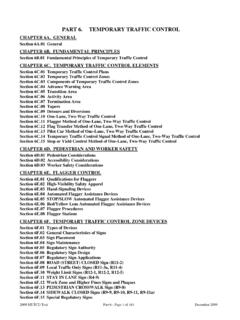Transcription of 29 March 2019 Oversize Overmass (OSOM) Vehicles - NHVR
1 Page 1 of 4 National Heavy vehicle Regulator | 2014 Oversize Overmass (OSOM) vehiclesWhat is a OSOM load-carrying vehicle ?An Oversize Overmass (OSOM) vehicle is a heavy vehicle that is carrying, or specially designed to carry, a large indivisible heavy vehicle is a Class 1 heavy vehicle if it, together with its load, does not comply with a prescribed mass requirement or prescribed dimension requirement applying to it and is a heavy vehicle carrying, or designed for the purpose of carrying, a large indivisible item including, for example, a combination including a low of OSOM Vehicles include a combination of prime movers, low loaders, low loader dollies, platform trailers and Class 1 OSOM vehicle does not require a permit to operate provided the movement of the vehicle complies with all of the requirements and travel conditions outlined in a transition notice.
2 Operators still need to comply with the operating conditions specified in their relevant transition a Class 1 OSOM vehicle does not comply with the mass or dimension limits set out in a transition notice, an operator must apply to the National Heavy vehicle Regulator (NHVR) to obtain a Mass or Dimension Exemption Vehicles :large indivisible item - an item that:- can not be divided without extreme effort, expense or risk of damage to it; can not be carried on any heavy vehicle without contravening a mass requirement or dimension loader - a trailer with a loading deck no more than 1m above the loader dolly - a device for distributing mass that:- is usually coupled between a prime mover and low loader; consists of a rigid frame of a gooseneck shape; does not directly carry any load.
3 Is equipped with 1 or more axles, a kingpin and a fifth wheel , in relation to a light, includes under Mass or Dimension Exemption Gazette Notice The NHVR may grant a Mass or Dimension Exemption Gazette Notice for a period of not more than five years to a Class 1 OSOM vehicle from a prescribed mass or dimension requirement. A Mass or Dimension Exemption Gazette Notice will include the following information: the category of heavy Vehicles to which the exemption applies the mass or dimension requirements the areas or routes to which the exemption applies the road conditions or travel conditions required by the relevant road manager/s the period for which the exemption appliesOperators can continue to operate under a current transition gazzette notice.
4 If the vehicle exceeds the requirements of the gazette you can apply to the NHVR to obtain a mass or Dimension Exemption notices or guidelines specific to the movement of OSOM Vehicles have seen consolidated into a national gazette 2 of 4 National Heavy vehicle Regulator Overmass vehiclesExemptions by permit The NHVR may grant a Mass or Dimension Exemption Permit for a period of not more than three years. For access to the road network that is not covered under a transition notice an application to the NHVR will be required. Will I have to apply for a permit again?All permits that were already in force at the time the Heavy vehicle National Law (HVNL) commenced continue to have effect as if they were made under the HVNL.
5 They will remain current until their expiry date or they are replaced under the national access framework, whichever comes first. All new and renewal permit applications must be directed to the NHVR. Where the dimensions of the vehicle are likely to interfere with overhead wires, bridges and other structures on or beside the road, approval to travel the route must be sought from the relevant authorities. These third party approvals will be required prior to the issue of a permit. It is the responsibility of the OSOM vehicle operator to obtain approval from the relevant organisation. For further details regarding third party providers please see the Third party utility provider fact sheet.
6 The driver of a Class 1 heavy vehicle who is driving the vehicle under a Mass or Dimension Exemption Permit must keep a copy of the permit in the driver s if my permit doesn t have an expiry date?In almost all cases, permits should have an expiry date attached to them. Some older permits which were issued in perpetuity continue to exist. In this small number of cases, the permits will continue under the HVNL for three years. At the end of the three year period, the permit will lapse and you must apply to the NHVR if you want the permit to be devicesIn some instances OSOM Vehicles may require conditions of operations such as warning devices or warning lights to operate on the road network.
7 If operating under a transition notice or a permit, these requirements will be specified in detail. Examples of warning devices that may apply to an OSOM lightsA warning light attached to a OSOM vehicle , when switched on, must: emit a yellow coloured light of rotating and flashing effect flash between 120 and 200 times a minute have a power of at least: if LED technology is used 25W, or if another technology is used 55W not be a strobe warning light attached to a OSOM vehicle must be: clearly visible at a distance of 500m in all directions, or supplemented by 1 or more additional warning lights so that the light emanating from at least 1 of them is clearly visible at a distance of 500m in any directionWarning flags4 brightly coloured red, red and yellow, or yellow flags, each at least 450mm by 450mm, fixed as follows: a flag must be attached at each side of the front of the vehicle or, if a load projects from the front of the vehicle , at each side of the front of the load.
8 A flag must be fixed at each side of the rear of the vehicle or, if a load projects from the rear of the vehicle , at each side of the rear of the lights and delineatorsIf a load projects more than 150mm beyond a side of a Class 1 heavy vehicle , and the projection is less than 500mm thick from top to bottom: a warning light must be attached to the vehicle 2 delineators must be attached to the projection in the way stated in subsection (2) on each side of the vehicle on which the load projects more than 3 of 4 National Heavy vehicle Regulator Overmass vehiclesThe delineators must be attached in the following way at least 1 delineator must be attached to the front of the projection and at least 1 delineator must be attached to the rear of the projection a delineator attached to the front of the projection must be attached so that its reflective surface is facing forward of the vehicle a delineator attached to the rear of the projection must be attached so that its reflective surface is facing rearward from the vehicle .
9 Delineator means a yellow, rigid piece of material that: is at least 300mm long and at least 300mm wide complies with Class 1 or 2 of AS 1906 Retro-reflective Materials and Devices for Road Traffic Control Purposes . Oversize signThe warning sign on a OSOM vehicle must be at least 1200mm long and at least 450mm high. The length of the sign may be split in two parts, in which case the combined length of its parts must be at least 1200mm. A warning sign on OSOM vehicle must have a face showing: the word Oversize , in black capital letters and in typeface Series C(N) complying with AS 1744 Forms of Letters and Numerals for Road SignsNote AS 1744 Forms of Letters and Numerals for Road Signs may be purchased from Standards Australia at the letters must be at least 200mm high and at least 125mm from the top and bottom of the warning the length of the warning sign is spilt into two parts.
10 The word OVER must be on the left part and the word SIZE on the right part there must be no border between the two parts both parts must be mounted at the same warning sign on a OSOM vehicle must be fitted horizontally. The lower edge of the warning sign must be: above the bottom bumper bar, or if there is no bumper bar, at least 500mm above ground level. The face of a warning sign on a Class 1 OSOM vehicle must have: a yellow surface complying with Class 1 or 2 of AS 1906 Retro-reflective Materials and Devices for Road Traffic Control Purposes a black border that is at least 20mm wide and, unless the sign is made with a box edge, whose outermost edge is at least 10mm in from the edge of the sign its manufacturer s name or trademark, and the brand and class of material aused for the warning sign s surface, permanently marked in letters at least 3mm but no more than 10mm high on any visible part of the warning sign on a OSOM vehicle must be made of stiff, flat, weatherproof material for example.

